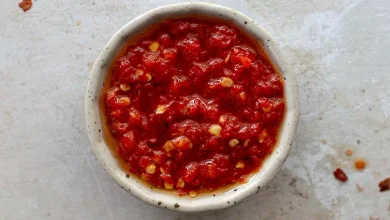Armenian Stuffed Vegetables, often referred to as Dolma, are a popular dish in Armenian and Middle Eastern cuisine. This dish consists of vegetables, typically grape leaves, bell peppers, zucchini, or eggplants, stuffed with a flavorful mixture of rice, ground meat (usually beef or lamb), and a variety of herbs and spices. Here’s a detailed response, with emojis as you requested:
🍽️ What is Armenian Stuffed Vegetables (Dolma)?
Armenian Dolma is a delectable dish that features vegetables filled with a mixture of rice, meat, and a combination of aromatic herbs and spices. The word “Dolma” comes from the Turkish word “dolmak,” which means “to fill” or “to stuff.” This dish is commonly served as an appetizer or a main course and is cherished for its rich flavors and the way it brings people together.
📜 Historical Background:
The history of Dolma is quite fascinating and dates back centuries. It’s believed to have originated in the Ottoman Empire, which included modern-day Turkey, parts of Greece, and many Middle Eastern countries. The concept of stuffing vegetables with grains and meat has ancient origins, but it became a staple in the cuisine of these regions. Each culture has added its own unique twists and variations to the dish over time.
📦 Components:
The key components of Armenian Stuffed Vegetables (Dolma) include:
- Vegetables: Grape leaves, bell peppers, zucchini, eggplants, or even cabbage leaves.
- Filling: A mixture of rice, ground meat (usually beef or lamb, but vegetarian versions also exist), finely chopped onions, garlic, herbs (such as mint, parsley, and dill), and spices (like allspice, black pepper, and paprika).
- Cooking Liquid: A combination of broth, water, lemon juice, and sometimes tomato sauce.
- Garnishes: Lemon wedges, fresh herbs, and yogurt for serving.
👩🍳 Steps to Prepare Armenian Dolma:
Here’s a simplified version of how to prepare Armenian Dolma using grape leaves:
-
Prepare the Leaves: If you’re using grape leaves, blanch them in boiling water to soften and remove any bitterness. Drain and set them aside.
-
Make the Filling: In a bowl, combine the rice, ground meat, chopped onions, garlic, herbs, and spices. Mix everything thoroughly.
-
Stuff the Vegetables: Place a grape leaf or other vegetable on a flat surface, add a spoonful of the filling in the center, fold the sides in, and roll it up tightly. Repeat this for all the vegetables.
-
Arrange in a Pot: Line the bottom of a large, heavy-bottomed pot with additional grape leaves. Carefully arrange the stuffed vegetables in layers, making sure they fit snugly.
-
Cooking Liquid: Mix the broth, water, lemon juice, and tomato sauce (if using) and pour this mixture over the stuffed vegetables. Place a heavy plate on top to keep them in place.
-
Simmer: Cover the pot and simmer over low heat for about 1 to 1.5 hours, or until the vegetables are tender and the filling is cooked.
-
Serve: Once cooked, let the Dolma cool slightly, and then serve it with lemon wedges, fresh herbs, and a side of yogurt.
⏰ Time Needed:
The preparation and cooking time can vary, but on average, making Armenian Stuffed Vegetables (Dolma) can take approximately 2 to 2.5 hours. This includes preparation, stuffing the vegetables, and the cooking time.
Now you’re all set to enjoy this delectable Armenian dish! 🍽️😋
Armenian Stuffed Vegetables (Dolma) can be a nutritious dish, but the nutritional content can vary depending on factors like the type of vegetables used, the amount of meat, and the cooking method. Here’s a general overview of the nutritional aspects and some health information:
Nutrition Facts (Approximate, Per Serving):
- Calories: Varies, typically 200-400 calories per serving.
- Protein: Varies based on meat or vegetarian options.
- Carbohydrates: Primarily from rice and vegetables, approximately 30-60 grams.
- Dietary Fiber: Good source, around 4-8 grams, especially with the use of vegetables.
- Fats: Depends on the type and amount of meat used. Can range from 5-20 grams.
- Vitamins and Minerals: Rich in vitamins (e.g., vitamin C, vitamin A) and minerals (e.g., iron and calcium) from the vegetables and herbs used.
- Sodium: Amount can vary significantly depending on the use of salt or broth in the recipe.
- Health Information: Armenian Dolma can be a nutritious dish when made with a balance of vegetables and lean meats or vegetarian alternatives. It’s a good source of dietary fiber, vitamins, and minerals.
Health Benefits:
- Vegetables: Dolma is a great way to incorporate a variety of vegetables into your diet. These provide essential vitamins, minerals, and antioxidants that support overall health.
- Fiber: The fiber content from the rice and vegetables promotes digestive health, helps control blood sugar levels, and can aid in weight management.
- Protein: If prepared with lean meats, Dolma can be a good source of protein, which is essential for muscle health and overall bodily functions.
- Low Fat Options: Vegetarian or lean meat versions can be a low-fat option that can help manage cholesterol and maintain a healthy weight.
Health Considerations:
- Calories: Depending on the ingredients and portion size, the calorie content can vary widely, so be mindful of portion control.
- Sodium: Watch the sodium content, especially if using canned ingredients or pre-made broths. High sodium intake can impact blood pressure and heart health.
- Allergies: Be cautious if there are allergies to any ingredients like nuts or specific herbs used in the recipe.
- Vegetarian/Vegan: If you’re following a vegetarian or vegan diet, Dolma can be made without meat while still being a nutritious option.
For precise nutritional information and health considerations, it’s best to calculate based on your specific recipe and portion sizes or consult a nutritionist or dietitian if you have dietary concerns or restrictions.



